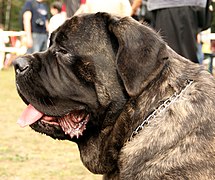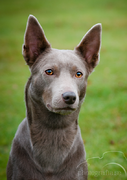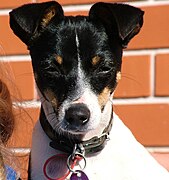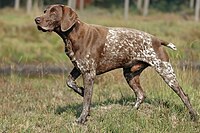User:Cavalryman/sandbox/sandbox 3
Dog breed[edit]
"a breed is “either a subspecific group of domestic livestock with definable and identifiable external characteristics that enable it to be separated by visual appraisal from other similarly defined groups within the same species, or a group for which geographical and/or cultural separation from phenotypically similar groups has led to acceptance of its separate identity.”"[1]
"A breed is a group of animals that has been selected by humans to have a uniform appearance that is inheritable and distinguishes it from other groups of animals within the same species. It is a product of artificial choice of characters that are not necessarily strategies for survival but are favoured by humans for economic, aesthetic, or ritual reasons, or because they increase the social status of the owner of the animals.[2]
"the definition of a breed: “A population of dogs sharing definable and inheritable phenotypic characteristics, after breeding undertaken by humans over a given period of time, allowing this population to be distinguished from other defined populations of dogs/or defined breeds.”"[3]
"Animal breeds have been defined as “a group of animals that has been selected by man to possess a uniform appearance that is inheritable and distinguishes it from other groups of animals within the same species.”"[4]
"The first evidence for potentially distinctive breeds of dogs dates to 3,000 years ago and is principally associated with ancient Egypt and Mesopotamia."[5]
"There do not, however, appear to have been distinctive [dog] breeds until about 3000-4000 years ago"[6]
"Since Roman times dog breeds have been developed to serve a multitude of functions"[7]
References[edit]
Citations[edit]
- ^ Food and Agriculture Organization (2022).
- ^ Clutton-Brock (1999), p. 40.
- ^ Fédération Cynologique Internationale (2019).
- ^ Sampson & Binns (2006), p. 19.
- ^ Young & Bannasch (2006), p. 48.
- ^ Clutton-Brock (1995), p. 16. sfnp error: multiple targets (2×): CITEREFClutton-Brock1995 (help)
- ^ Clutton-Brock (1995), p. 18. sfnp error: multiple targets (2×): CITEREFClutton-Brock1995 (help)
Bibliography[edit]
- Clutton-Brock, Juliet (1999). A natural history of domesticated mammals (2nd ed.). Cambridge: Cambridge University Press. ISBN 978-0521632478.
- Clutton-Brock, Juliet (1995). "Origins of the dog". In Serpell, James (ed.). The domestic dog: its evolution, behaviour and interactions with people. Cambridge University Press. ISBN 0-521-41529-2.
- "FCI Standing Orders, Enclosure 5: FCI procedure for the international recognition of a new breed (provisional)" (PDF). Fédération Cynologique Internationale. 29 April 2019. Retrieved 18 February 2022.
- "Animal genetics: What are animal genetic resources?". Food and Agriculture Organization of the United Nations. 2022. Retrieved 18 February 2022.
- Sampson, J.; Binns, M. M. (2006). "The Kennel Club and the early history of dog shows and breed clubs". In Ostrander, Elaine A.; Giger, Urs; Lindblad-Toh, Kerstin (eds.). The dog and its genome. Cold Spring Harbor: Cold Spring Harbor Laboratory Press. ISBN 0-87969-742-3.
- Young, Amy; Bannasch, Danika (2006). "Morphological variation in the dog". In Ostrander, Elaine A.; Giger, Urs; Lindblad-Toh, Kerstin (eds.). The dog and its genome. Cold Spring Harbor: Cold Spring Harbor Laboratory Press. ISBN 0-87969-742-3.
Dog[edit]
Development of types and breeds[edit]
The evidence of broad breed types began to emerge 3000-4000 years ago; there is clear evidence of the existence of sighthound-type dogs in Egyptian and western Asian paintings and pottery from this period.[1] By the Roman Era most of the main dog types known today existed and their roles well defined and the Romans were aware that selective breeding could alter both appearance and temperament.[1]
Description[edit]
The domestic dog displays a great deal of diversity in size, shape and appearance, the diversity of size is the greatest of any species of animal.[4] The dog's size range seems to roughly correlate with the range of sizes found naturally in the the Caninae family,[5] with weight ranging from 2 kilograms (4.4 lb) for some smaller toy dogs to over 100 kilograms (220 lb) for some larger types like mastiffs.[6] All healthy dogs, regardless of their size and type, have an identical skeletal structure with the exception of the number of bones in the tail.[7][8] The dog’s skeleton is well adapted for running; the vertebrae on the neck and back have extensions for powerful back muscles to connect to, the long ribs provide plenty of room for the heart and lungs, and the shoulders are unattached to the skeleton allowing great flexibility.[7][8] Compared to the dog's wolf like ancestors, selective breeding since domestication has seen the dog's skeleton greatly enhanced in size for larger types such as mastiffs and miniaturised for smaller types such as terriers; dwarfism has been selectively utilised for some types where short legs are advantageous such as dachshunds and corgis.[8]
The domestic dog's head shows significant divergence between types in terms of size and shape, although the skull has identical components regardless of breed type.[8][9] The three basic skull shapes are the elongated dolichocephalic type as seen in sighthounds, the intermediate mesocephalic or mesaticephalic type, and the very short and broad brachycephalic type exemplified by mastiff type skulls.[8][9] Compared to to other canids which all have erect and mobile ears, the dog's ears have been modified more than most other aspects of their body with significant variation seen within the species.[10][6] Selective breeding has seen the the dog's ears modified to take a number of forms, from pricked ears like those seen wild canids to long and pendulous ears that hang towards the ground, with semi-erect and pendant type ears seen in between.[10] Compared to wild canids, domestic dogs with erect ears see a stiffening of the ears at a much later stage of maturity.[6]
Dog's tails also show a great deal of variation in terms of shape and length; in wild canids the tail is usually long and straight and when not being used for communication is carried in a downward pointing direction.[6] Comparatively the tails of almost all domestic dogs display some form of upwards curve, the degree of curve seen within varies significantly between types, from almost straight to helical, giving the impression of almost being knotted.[6] Most dogs naturally have 26 vertebrae in their tails, but some with naturally short tails have as few as three.[7]
One of the most distinguishing and variable aspects of dogs is their coat, the coat can vary in length, texture, density and colour.[11][12] Variation in dog's coats is not only seen between types and breeds depending upon the their function or breeding, but also within breeds[11][12]
-
Dog skeleton
-
Dolichocephalic skull
-
Mesocephalic skull
-
Brachycephalic skull
-
Pricked ears
-
Semi-pricked ears
-
Pendant ears
-
Pendulous ears
References[edit]
- ^ a b c Clutton-Brock, Juliet (1995). "Origins of the dog". In Serpell, James (ed.). The Domestic Dog: Its Evolution, Behaviour and Interactions with People. Cambridge University Press. pp. 7–20. ISBN 0521415292.
- ^ Coppinger, Raymond; Schneider, Richard (1995). "Evolution of working dogs". In Serpell, James (ed.). The domestic dog: its evolution, behaviour, and interactions with people. Cambridge: Cambridge University Press. pp. 22–47. ISBN 978-0521425377.
- ^ Coppinger, Raymond; Coppinger, Lorna (2001). Dogs: a startling new understanding of canine origin, behavior & evolution. New York: Scribner. ISBN 0-684-85530-5.
- ^ Bradshaw (2011), pp. 56-57 & 87.
- ^ Fogle (2009), p. 38. sfnp error: multiple targets (3×): CITEREFFogle2009 (help)
- ^ a b c d e McLoughlin (1983), p. 84.
- ^ a b c Cunliffe (2004), p. 12.
- ^ a b c d e Fogle (2009), pp. 38–39. sfnp error: multiple targets (3×): CITEREFFogle2009 (help)
- ^ a b Jones & Hamilton (1971), p. 27.
- ^ a b Fogle (2009), p. 51. sfnp error: multiple targets (3×): CITEREFFogle2009 (help)
- ^ a b Cunliffe (2004), pp. 20–21.
- ^ a b Alderton (2008), pp. 22–27.
- Alderton, David (2008). The encyclopedia of dogs. Bath: Parragon Books Ltd. ISBN 978-1-4454-0853-8.
- Bradshaw, John (2011). In defence of dogs. London: Penguin Books Ltd. ISBN 978-1-846-14295-6.
- Cunliffe, Juliette (2004). The encylopedia of dog breeds. Bath: Paragon Books. ISBN 0-75258-018-3.
- Fogle, Bruce (2009). The encyclopedia of the dog. New York: DK Publishing. ISBN 978-0-7566-6004-8.
- Jones, Arthur F.; Hamilton, Ferelith (1971). The world encyclopedia of dogs. New York: Galahad Books. ISBN 0-88365-302-8.
- McLoughlin, John C. (1983). The canine clan: a new look at man's best friend. New York: The Viking Press. ISBN 0-067-20264-9.
{{cite book}}: Check|isbn=value: checksum (help)
Gundog[edit]
A gundog, or gun dog, is a type of dog used to aid a hunter in finding game to be shot, collecting game that has been shot or both, the term is also used to describe any dog of a breed that was developed for those purposes. Whilst considered a type themselves, gundogs are actually a grouping of distinct dog types with diverse heritages and varied appearances who have a common role. Whilst the term gundog is relatively recent, postdating the invention of the firearms, the ancestors of modern gundogs accompanied hunters from the middle ages, aiding hunters catch game with nets, falcons, and bows and arrows.
Types[edit]
Gundogs are usually divided into five subgroups, pointers, spaniels, setters, retrievers and water dogs.[1]
Pointers[edit]
Pointers are named after the stance they adopt when they detect the scent game, the pointer freezes "pointing" at the game with its nose as a visual sign to the hunter where hidden game is.[2] It is commonly supposed that the pointers descended from the Old Spanish Pointer which were used well before the advent of firearms by Iberian hunters as early as the 16th century to locate quarry and stand bolt still whilst hunters moved forward with nets to net the game.[1] or a hawk or falcon was loosed and the game was flushed
Retrievers[edit]
Setters[edit]
Like pointers, the long haired setters are named after the stances they adopt when they detect the scent game, the setter crouches or "sets" to indicate the hunter where the game is.[1][3] Well before the advent of the firearm in Europe, the ancestors of the setter were used as early as the Middle Ages to find and hold quarry for hunters, they were trained to crouch before game whilst hunters to draw nets over the birds, often kite hawks or falcons were also flown overhead, further deterring any gamebirds from taking off.[4] In the 15th century Edward, 2nd Duke of York wrote about "setting spaniels" in his The Master of Game,[5] at the time the term spaniel being applied to any long haired dogs not used as pack hounds,[6] whilst the term setter was common in Britain from at least the 16th century, in 1597 John Caius wrote about them in his Of Englishe dogges.[7] With the introduction of firearms for hunting, the setter was adapted to the role of accompanying the shooter. Many writers state setters are purely British, although others include the French épagneuls (spaniels), the Dutch stabyhouns, within the type.
in Britain
Spaniels[edit]
Water dogs[edit]
Kennel club classification[edit]
When competing in conformation shows most kennel clubs, including the The Kennel Club group pedigree gundog breeds together in their own gundog group, whilst some such as the American Kennel Club group them in a sporting group.[8][9]
See also[edit]
References[edit]
Citations[edit]
- ^ a b c Fogle (2009), p. 202. sfnp error: multiple targets (3×): CITEREFFogle2009 (help)
- ^ Blüchel (2005), p. 400.
- ^ Blüchel (2005), p. 408.
- ^ Hancock (2013), pp. 23–24. sfnp error: multiple targets (2×): CITEREFHancock2013 (help)
- ^ Edward, 2nd Duke of York (1406–1413).
- ^ Hancock (2013), p. 26. sfnp error: multiple targets (2×): CITEREFHancock2013 (help)
- ^ Caius (1576), pp. 14–15.
- ^ The Kennel Club Ltd (2020), "Gundog Group".
- ^ American Kennel Club, Inc (2020), "Sporting Group".
Bibliography[edit]
- American Kennel Club, Inc (2020), American Kennel Club, New York
{{citation}}: CS1 maint: location missing publisher (link)
- Blüchel, Kurt G. (2005). Game and hunting. Königswinter: Tandem Verlag GmbH. ISBN 3-8331-1263-8.
- Caius, John (1576). Of Englishe dogges the diuersities, the names, the natures, and the properties. London: John Charlewood for Rychard Iohnes.
- Edward, 2nd Duke of York (1406–1413). The master of game. London.
{{cite book}}: CS1 maint: numeric names: authors list (link)
- Fergus, Charles (2002). Gun dog breeds: a guide to spaniels, retrievers and pointing dogs. Guilford, Connecticut: The Lyons Press. ISBN 1-58574-618-5.
- Fogle, Bruce (2009). The encyclopedia of the dog. New York: DK Publishing. ISBN 978-0-7566-6004-8.
- Hancock, David (2013). Gundogs: their past, their present and their prospects. Marlborough, Wiltshire: The Crowood Press Ltd. ISBN 978-1-84797-492-1.
- Hudson, David (1995). The shooting man's dog: a complete guide to gundogs. Shrewsbury: Swan Hill Press. ISBN 1-85310-560-0.
- The Kennel Club Ltd (2020), The Kennel Club, London
{{citation}}: CS1 maint: location missing publisher (link)
- Morris, Desmond (2001). Dogs: the ultimate dictionary of over 1,000 dog breeds. North Pomfret, VT: Trafalgar Square Publishing. ISBN 1-57076-219-8.
- Moxon, P. R. A. (1970). Gundogs: training and field trials. London: Hutchinson Publishing Group. ISBN 0-09-121670-2.
- Walker, Adrian (1999). The encyclopedia of falconry. Lanham, Maryland: The Derydale Press. ISBN 1-56416-174-9.
- Wilcox, Bonnie; Walkowicz, Chris (1995). Atlas of dog breeds of the world. Neptune City, N.J.: TFH Publications.
Red Decoy Dog[edit]
| Red Decoy Dog | |
|---|---|
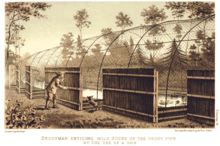 | |
| Other names | Decoy Dog |
| Breed status | Extinct |
| Dog (domestic dog) | |
The Red Decoy Dog, also known as the Decoy Dog, was a now extinct breed of gundog from England. Used to lure waterfowl into large netted traps, the Red Decoy Dog is believed to be the progenitor of the Canadian Nova Scotia Duck Tolling Retriever.
Overview[edit]
Description[edit]
In his 1886 work The book of duck decoys, Sir Ralph Payne-Gallwey describes a good decoy dog as “a bright little fellow, about a third smaller than a Fox, with a curly bushy tail if possible, and of red or yellow colour.”[6]
See also[edit]
References[edit]
- ^ Billett, Michael (1994). A history of English country sports. London: Robert Hale. p. 113. ISBN 0-7090-5238-3.
- ^ Fogle, Bruce (2009). The encyclopedia of the dog. New York: DK Publishing. p. 220. ISBN 978-0-7566-6004-8.
- ^ Hancock, David (2013). Gundogs: their past, their performance and their prospects. Ramsbury, Marlborough: The Crowood Press Ltd. pp. 43–46. ISBN 978-1-84797-492-1.
- ^ Jesse, George R. (1866). Researches into the history of the British dog: from ancient laws, charters, and historical records. Vol. 1. London: Robert Hardwicke. p. 160.
- ^ Morris, Desmond (2001). Dogs: the ultimate dictionary of over 1,000 dog breeds. North Pomfret, VT: Trafalgar Square Publishing. p. 281. ISBN 1-57076-219-8.
- ^ Payne-Gallwey, Ralph (1886). The book of duck decoys: their construction, management, and history. London: John Van Voorst. pp. 48–50.
Category:Dog breeds originating in England Category:Extinct dog breeds Category:Gundogs












